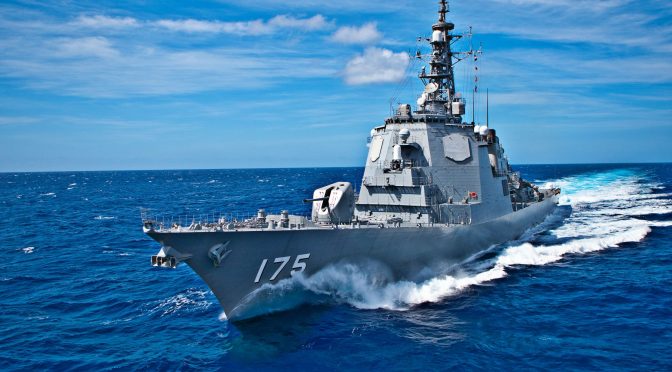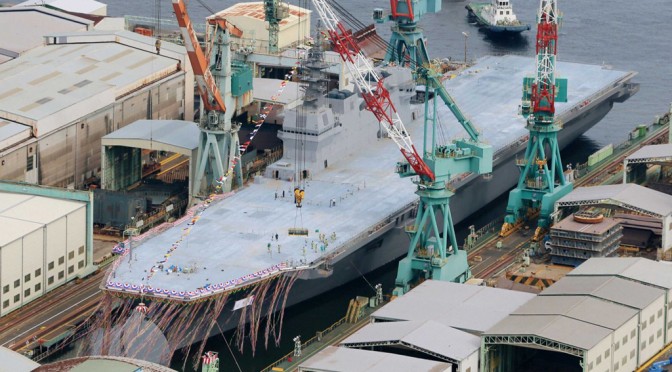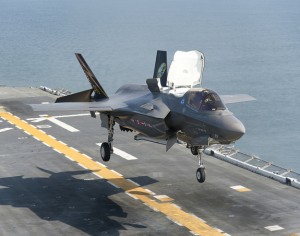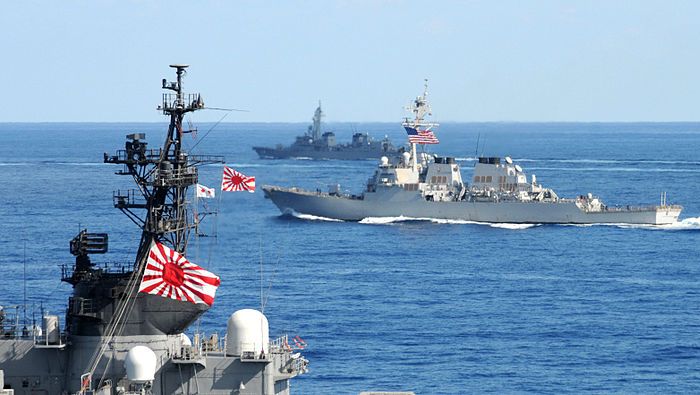By Jason Y. Osuga
Introduction
“Our history is clear that nations with strong allies thrive, and those without them wither. My key words are solvency and security to protect the American people. My priorities as SECDEF are strengthening readiness, strengthening alliances, and bring business reform to DOD.” – General James Mattis (ret.), SECDEF Confirmation Hearing, 1/11/17
At current growth rates, China may become a comparable power to the United States in economic and military terms in the not too distant future. In this future world, China will be less constrained than it is today to attempt to coerce other Asian nations to its will.[1] China’s economy may be slowing at the moment, with significant concerns over sustainability of high debt and growth.[2] Notwithstanding, China is still set to overtake the United States between 2030 and 2045 based on the global power index, which is calculated by Gross Domestic Product, population size, military spending, and technology, as well as new metrics in health, education, and governance.[3] An unbalanced multipolar structure is most prone to deadly conflict compared to a bipolar or balanced multipolar structure.[4]
The execution of the responsibility as the regional balancer requires political will, military capability, and the right grand strategy.[5] While it is difficult to dictate or gauge the political will in an unknown future situation, the U.S. can hedge by building capability and advocating a forward strategy to support partners in the region. One of the ways in which the U.S. can increase joint warfighting capability is through the co-development of defense platforms with key allies such as Japan. Increasing Japan’s warfighting capability is in keeping with a grand strategy of forging an effective maritime balance of power to curb growing threats from revisionist powers such as China and Russia. Production of a common frigate platform would enhance bilateral collective defense by increasing joint interoperability. Designing a ship based on bilateral warfighting requirements would enhance interoperability and concepts of operations in joint warfighting.
The joint development of frigates would deepen the U.S.-Japan security alliance and enhance the regional balance of power to offset China. Operationally, co-development of frigates will increase interoperability, reduce seams in existing naval strategy, and increase fleet size and presence. Industrially, a joint venture will reduce costs of shipbuilding through burden-sharing research and development (R&D), maximizing economy of scale production, and exploiting the comparative advantage in the defense sectors to favor both nations. Logistically, developing a shared platform enhances supply and maintenance capability through interchangeable components, streamlined bilateral inventory, and increased capability to conduct expeditionary repairs of battle damage.
Reducing Seams in Naval Strategy and Forward Presence
A major argument for joint development of a frigate is increasing fleet size of the USN and the JMSDF. The Navy has advocated for a fleet size of 355 ships.[6] The Center for Strategic Budget Assessments (CSBA) recommended 340 ships, and MITRE recommended a total force structure of 414 ships to meet fleet requirements.[7]
One of the main rationales behind these recommendations has been the People’s Liberation Army Navy (PLAN), which has increased its naval ship construction on a vast scale to push the U.S. Navy and JMSDF out of the first island chain.[8] China continues to produce the JIANGKAI II-class FFG (Type 054A), with 20 ships currently in the fleet and five in various stages of construction.[9] 25 JIANGDAO-class corvettes FFL (Type 056) are in service and China may build more than 60 of this class, along with 60 HOUBEI-class wave-piercing catamaran guided-missile patrol boats PTG (Type 022) built for operations in China’s “near seas.”[10] Furthermore, the PLAN continues to emphasize anti-surface warfare as its primary focus by modernizing its advanced ASCMs and associated over-the-horizon targeting systems.[11] According to Rear Admiral Michael McDevitt (ret.), by 2020, China will boast the largest navy in the world measured by the number of combatants, submarines, and combat logistics vessels expected to be in service.[12] According to CNAS, China “will be a Blue-Water Naval Power by 2030” approaching 500 ships.[13]

Not only is the PLAN building more frigates and ASCMs, but it also “enjoys home field advantage.”[14] Therefore, despite the PLA’s overall military inferiority vis-à-vis the U.S. military, the U.S. can execute only a partial commitment of forces to Asia due to its global commitments.[15] China can offset a fraction of the U.S. Navy with the combined might of the PLAN, PLA Air Force, and the PLA Rocket Force with anti-ship missiles, combat aircraft, and missile-capable submarines and patrol craft to deny the U.S. access to waters within the first island chain.[16] Thus, the PLA is quickly becoming a balanced force.[17] A balanced and regionally-concentrated force is creating a growing gap in the ability of the U.S. Navy or JMSDF to gain sea control. The USN and JMSDF require more surface combatants to prosecute an effective sea control strategy. One of the best ways to increase fleet size and sea presence is through building a common frigate.
Operational Advantages and Distributed Warfighting
A new class of frigate would be in line with the Chief of Naval Operations ADM Richardson’s vision in “The Future Navy,” that a “355-ship Navy using current technology is insufficient for maintaining maritime superiority. The Navy must also implement new ways of operating our battle fleet, which will comprise new types of ships.”[18] The platform would be an opportunity to solidify the distributed lethality (DL) concept, promulgated by Commander Naval Surface Force’s Surface Force Strategy.[19] DL combines more powerful ships with innovative methods of employing them by dispersing lethal capabilities. The more distributed allied combat power becomes, the more enemy targets are held at risk, and the costs of defense to the adversary becomes higher.[20] Furthermore, the more capable platforms the adversary has to account for, the more widely dispersed its surveillance assets will be, and more diluted its attack densities become.[21] If the U.S. and Japan can increase the number of platforms and employ them in a bilateral DL architecture, it would present a tracking and salvo problem for the enemy. The new Surface Force Strategy requires an increased fleet size to amass greater number of ships forward-deployed and dispersed in theater.[22]
Within a hunter-killer surface action group acting under the DL operational construct, Aegis destroyers and cruisers would protect the frigates from air and distant missile threats, allowing the frigates to focus on the SUW/ASW mission sets. The ship’s self-defense systems can provide point or limited area defense against closer air and missile threats. The main mission of the sea control frigate, however, will be to help deliver payloads integrated into the Naval Integrated Fire Control-Counter Air (NIFC-CA) architecture through Cooperative Engagement Capability (CEC).[23] Payloads launched by any ship in USN or JMSDF can be terminally guided by nodes in the CEC. The JMSDF is already moving toward integrating a greater portion of its fleet into the U.S. NIFC-CA architecture through combat systems modification to existing ships.[24]
A Frigate for High-Threat Sea Control
The U.S. and Japan should consider a joint venture to develop a common frigate, displacing roughly 4000-5000 tons, whose primary missions are anti-surface warfare (SUW), anti-submarine warfare (ASW), and limited-area air defense/anti-air warfare AD/AAW. In addition to increasing interoperability, a frigate dedicated to these sea control missions would reduce mission shortfalls in the current naval strategy and fleet architecture. Aegis platforms, such as the Arleigh Burke-class destroyers (DDG) and Ticonderoga-class cruisers (CG), must perform myriad missions such as theater ballistic missile defense (BMD) and air defense (AD) of the strike groups, in addition to theater ASW and SUW. While half of the CGs undergo modernization and the cruiser’s long-term replacement is undecided,[25] and where the Littoral Combat Ships (LCS) do not yet provide robust SUW and ASW capabilities,[26] the DDGs must shoulder a larger share of the burden of those missions. Thus, the Navy would benefit from a dedicated and capable platform to conduct SUW and ASW for achieving sea control and burden-sharing with Aegis platforms. A new class of frigate would be in line with the Chief of Naval Operations ADM Richardson’s vision in “The Future Navy,” that a “355-ship Navy using current technology is insufficient for maintaining maritime superiority. The Navy must also implement new ways of operating our battle fleet, which will comprise new types of ships.”[27]
The frigate could escort ESGs, CSGs, logistics ships, and maritime commerce. A limited AD capability would fill the gap in protecting Aegis ships while the latter performs BMD missions, as well as escorting high-value units such as amphibious ships LHD/LHA, LPDs, and aircraft carriers (CVN). These specializations would benefit the planners’ ability to achieve sea control by enhancing the expeditionary and carrier strike groups’ defensive and offensive capabilities. It could also highlight the ability of future JMSDF frigates to integrate into U.S. CSGs, ESGs, and surface action groups (SAG) as practiced by its vessels in exercises such as Rim of the Pacific (RIMPAC) and ANNUALEX.
In a contingency, it is necessary to protect commercial shipping, logistics ships, and pre-positioned supply ships, which are the Achilles’ heel of the fleet. These links in fleet logistics chain are critical to sustaining long-duration operations and maintaining the economic well-being of maritime nations such as Japan and the U.S. Therefore, a sufficient number of frigates would be necessary to provide protection to logistics ships. As far as small combatant vessels, the Navy currently operates eight LCS from a peak of 115 frigates during the Cold War in 1987.
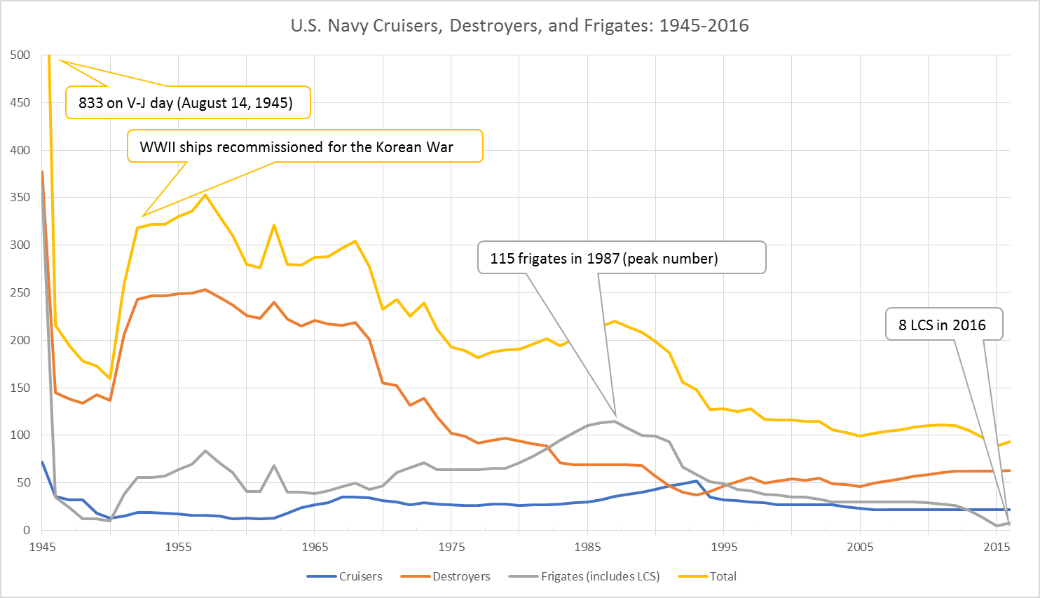
As for the ASW mission, the future frigate should be equipped with an active sonar, a towed passive sonar, an MH-60R (ASW-capable), and a long-range anti-submarine rocket (ASROC) system. A modern hull-mounted sonar connected to the future combat system could integrate the data acquired by towed or variable-depth sonars. It should also be built on a modular design with enough rack space set aside for future growth of systems to accommodate future mission modules. Therefore, the future frigate should have a greater length and beam compared to the LCS to accommodate more space for sensors, unmanned platforms, and combat systems. This should not be confused with a modular concept of the LCS where ASW, SUW, or mine warfare modules can be laboriously swapped out in port in a time-consuming process. The future frigate should focus on ASW/SUW superiority with limited area AD capabilities, and not have to change mission modules to complete this task. These frigates also would not replace the LCS. The LCS could continue to play a niche role in the SAGs as a carrier for drones and UAV/USV/UUV. Thus, the protection of the LCS from attacks will be an important factor, which will fall on the DDGs and future frigates to contribute.
Payloads and sensors have as much importance as platforms in the network-centric distributed lethality concept.[29] Effective joint warfighting requires not just cooperation in platform development, but also requires an emphasis on payload and sensor development.[30] The U.S. and Japan should explore joint R&D of the following payloads in the future frigate: Long Range Anti-Ship Missile (LRASM), Naval Strike Missile, and the surface-to-surface Hellfire missile. Out of these options or a combination thereof, the U.S. and Japan may find the replacement to the U.S. Navy’s RGM-84 Harpoon anti-ship missile and the JMSDF’s Type 90 ship-to-ship missile in service since 1992.[31]
The selection of payloads for the next frigate should be based on bilateral requirements of roles and missions. Furthermore, discussions should also involve offensive and defensive options in non-kinetic electronic warfare (EW) and cyber capabilities for joint development. Effective EW and cyber capabilities will increase the options for commanding officers and task force commanders to achieve the desired effect on the operating environment. A joint development will provide both fleet commanders options to achieve this effect.
Addressing Sufficiency
As far as increasing fleet size with next-generation frigates, how many frigates is enough? Based on global commitments for the U.S. Navy and regional commitments for the JMSDF, 60 frigates for the USN and 20 frigates for the JMSDF would be justified. By building 60 frigates, the U.S. Navy would be able to forward-deploy at least one-third (20 frigates) to the Western Pacific. The frigates should be dispersed and forward-deployed to U.S. naval bases in Japan, Guam, Singapore, and Hawaii as well as those on 7-month deployments from the continental U.S. The JMSDF would also build 20 frigates of the same class. Taken together, there would be a total of 40 frigates of the class in the Western Pacific between the USN and JMSDF. This ratio parity (1:1) would benefit the planners’ ability to conduct joint task force operational planning as well as factoring in collective self-defense considerations. 40 frigates would create enough mass to establish a distributed and forward sea presence, and when required, gain sea control with Aegis DDGs in hunter-killer SAGs.
Meanwhile, the JMSDF has not built 20 ships of any combatant class. Setting the goal high with 20 vessels of the next frigate would be an important milestone for the JMSDF toward increasing its fleet size in a meaningful way. The JMSDF recently announced that, to speed up vessel production and increase patrol presence in the East China Sea, it would build two frigates per year compared to one destroyer per year.[32] It appears the JMSDF is also realigning its strategy and procurement to cope with the changing security environment in East Asia.
Industrial Advantages of Joint Development
Bilateral development of the next frigate will enjoy industrial advantages in burden-sharing R&D, maximizing economy of scale production, and exploiting the comparative advantage of the U.S. and Japanese defense sectors. Burden-sharing R&D through cooperative development helps to reduce risks. Barry Posen, director of the MIT Security Studies Program, advocates burden-sharing as a central issue of alliance diplomacy.[33] Joint R&D mitigates risk through technology flow between two countries. Any newly developed or discovered technologies can be shared as part of the platform’s development. Thus, U.S. and Japan can tailor regulations on technology flow and export control laws to suit the scope of this bilateral development project to ensure seamless integration and manage risk.
Moreover, maximizing economies of scale production would help mitigate the rising costs of producing warships and weapons systems under unilateral R&D. Economy of scale coproduction or co-development program would be “consistent with Congress’ preference for allied cooperation in arms development (Nunn Amendment), by reducing acquisition costs and freeing resources for other burden sharing.”[34] A joint development with a close U.S. ally with a similar technology base and history of shared platforms development would make sense to cut costs, share technology, and hedge R&D risk. The U.S. and Japan have begun to move in the direction of cooperative development. In 2014, the U.S. Ambassador to Japan, Caroline Kennedy, and Japan Foreign Minister, Fumio Kishida, announced that the Defense Ministry and the DOD would hold studies to jointly develop a new high speed vessel under the bilateral Mutual Defense Assistance (MDA) agreement.[35] Although not many details were released to the public on this agreement, the studies may have centered on the LCS as a possible platform to base the bilateral project. A joint frigate project should be designed on a platform that addresses all of the LCS’ deficiencies and that meets bilateral requirements to achieve sea control via SUW/ASW superiority and distributed lethality.
Leveraging the economy of scale through joint development would also help Japan as its defense systems have also become more expensive to develop unilaterally. Many Japanese firms view international defense business as unstable and unproven in terms of profitability.[36] However, recent JMSDF Chief of Maritime Staff, ADM Takei, saw opportunities for cooperative development as Japanese defense industry has high-end technology, but lacks expertise and experience.[37] ADM Takei believed there is much potential for subsidiaries of major Japanese corporations that specialize in defense production to cooperate with U.S. defense firms to partner in the development or become a supplier of parts for U.S.-made equipment.[38] Thus, by cooperating in shipbuilding, the U.S. and Japan would benefit from reduced costs of production of components and systems by taking advantage of economies of scale.
Joint development will also leverage the comparative advantage of the respective industrial sectors to favor both nations. For example, if the U.S. produces something relatively better or cheaper than Japan such as the weapons, radar, or combat systems, the U.S. could take the lead in developing and building the systems for both countries. Conversely, if Japan produces a section or component of the ship better or cheaper than the U.S. (e.g., auxiliaries, propulsion, or hull), Japan could take the lead in developing it for both countries. However, domestic constituency and laws may prevent efficient production based on comparative advantages in the U.S. and Japan. The Buy American Act of 1933 requires the U.S. government to give preference to products made in the United States.
In light of cultural and historical opposition to buying foreign-made ships in both countries, a practical solution would be if both countries produced its own hulls in their domestic shipyards based on the same design. This would preserve American and Japanese shipbuilding and defense jobs in their home constituencies. Comparative advantage production, though, should be sought in auxiliary/propulsion systems, weapons, and radars to make the venture as joint and cost-effective as possible. Cost savings would not be as great if both countries produced its own ships; however, there is still a net positive effect derived from increased interoperability, joint R&D, and common maintenance practice from a shared platform.[39] This would ultimately translate to increased collective security for both countries and a stronger alliance which cannot be measured solely by monetary savings.
Logistical and Maintenance Advantages
U.S.-Japan joint frigate development offers maintenance and logistical advantages. The USN and JMSDF utilize similar logistics hubs currently in forward-deployed bases in Japan. The U.S. and Japan can find efficiency by leveraging existing logistics chains and maintenance facilities by building a platform based on shared components. Theoretically, a JMSDF frigate could be serviced in a USN repair facility, while a USN frigate could be maintained in a JMSDF repair facility if the platform is essentially built on the same blueprint. This may help reduce maintenance backlogs by making efficient use of USN and JMSDF repair yards. Furthermore, the use of common components would make parts more interchangeable and would also derive efficiency in stockpiling spares usable by both fleets.
Recently, the JMSDF and USN participated in a first of a kind exchange of maintenance parts between USS Stethem (DDG-63) and destroyer JS Ikazuchi (DD-107) during Exercise MultiSail 17 in Guam.[40] It was the first time in which U.S. and Japan used the existing acquisition and cross-servicing agreements (ACSA) to exchange goods between ships. The significance was that ACSA transfers are usually conducted at the fleet depot or combatant command (PACOM) levels, and not at the unit level. As U.S. and Japan devise creative ways to increase interoperability, commonalities in provisions, fuel, transportation, ammunition, and equipment would add to the ease of streamlining the acquisition and exchange process. Ships built on the same blueprint would in theory have all these in common.
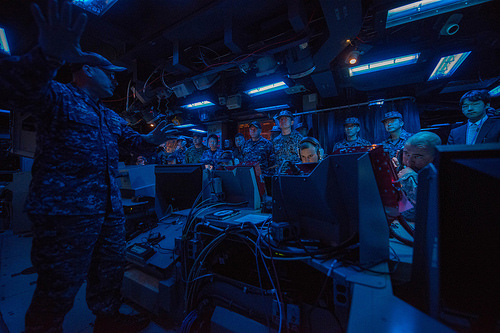
Common parts and maintenance would also improve theater operational logistics in the Fifth and Seventh Fleet AORs. For counter-piracy deployments to the Indian Ocean and Gulf of Aden, the JMSDF would be able to utilize U.S. logistics hubs in Djibouti, Bahrain, Diego Garcia, Perth, and Singapore to obtain parts more readily or perform emergency repairs. Guam, Japan, and Hawaii could be hubs in the Pacific to deliver common parts or perform maintenance on the shared frigate platform. The U.S. can expand its parts base and utilize ACSA to accept payment in kind or monetary reimbursement. Most importantly, the benefit to warfighters is that vessels would not be beholden solely to the logistics systems of their own country. Rather, ships can rely on a bilateral inventory and maintenance availability leading to enhanced collective security and a closer alliance.
Damage Repairs in Overseas Ports
Besides regular maintenance, the doctrinal shift to a more offensive strategy of distributed lethality requires that the Navy address the potential for a surge in battle damage.[41] There is a potential for an upsurge in battle damage as ships are more widely dispersed with a greater offensive posture, which may lead to a distributed vulnerability to taking casualties.[42] This prospect requires the Navy to focus on increasing the repair capability of naval platforms in forward ports.[43] Therefore, the need to conduct expeditionary repair, or the ability to swiftly repair naval ships that take on battle damage, becomes more important and challenging.[44] The four repair facilities in the Pacific best positioned to repair ships that receive damage are located in Guam, San Diego, Everett, and Pearl Harbor, as well as at the joint U.S.-Japanese ship repair service in Yokosuka, Japan.[45] A common U.S.-Japan platform that shares the same design and components would be better able to repair battle damage in forward repair facilities in an expeditionary and expeditious manner. Spreading the battle repair capability across the theater reduces risks in the offensively-postured DL concept.
Counterarguments
The U.S. Navy and JMSDF have achieved strong interoperability through years of conducting bilateral exercises. Having both nations producing their own warships and then achieving close interoperability through joint operations remain a convincing argument to maintain the status quo. Foreign Military Sales (FMS) have been useful mechanisms to transfer U.S. technology and reaping the benefit of technology flowback from Japanese R&D. The current system of Japan license-producing U.S. systems has preserved Japan’s status as an important client of U.S. defense systems.
The Fighter Support Experimental (FS-X) co-development project in the 1980s showed that terms and conditions of technology transfer and flowback must be equitably worked out, or Japan may also balk at pursuing a joint development with the U.S. Japan received U.S. assistance for the first time in the design and development of an advanced fighter.[46] The Japanese saw co-development as a next stage in the process toward indigenous production, as the technical data packages transferred not only manufacturing processes or “know-how,” but full design process or “know-why” as well.[47] Prominent politicians, however, such as the former-Governor of Tokyo, Shintaro Ishihara, clamored in op-ed pieces for Japan to step out from “Uncle Sam’s shadow” and pursue an independent development vice a joint development.”[48] Speaking for many of the Japanese policy elites who shared his sentiments, the FSX would “give away [Japan’s] most advanced defense technology to the United States but pay licensing and patent fees for each piece of technology we use. Washington refuses to give us the know-how we need most, attaches a battery of restrictions to the rest and denies us commercial spinoffs.”[49] If the terms of co-development such as technology flowback and terms and conditions of tech transfer are not equitably worked out, Japan may also balk at pursuing a joint development with the U.S.
These arguments have strong logic, but they still have flaws. Japan has followed the license-production model of producing U.S. systems for decades following WWII. To provide a few examples, Japan has produced the F-104 fighter, SH-60 helicopter, P-3C Orion anti-submarine patrol craft, and Patriot missiles under license. In many instances, Japanese engineers made significant improvements and enhancements to U.S. designs.[50] While license-production has advantages in guaranteeing technology flowback, it only works if the platform being license-produced is already a proven effective platform. In the case of frigates, there is no such platform yet. The LCS has too many issues for it to be a viable future frigate that could replace JMSDF’s light escort destroyers. With no viable alternative to the future frigate design, the U.S. risks “going at it alone” on a program that has already consumed precious time and resources on the problematic LCS program. It is unlikely that Japan would want to produce or buy an ineffective and problematic platform.
Finally, the age of Japan license-producing U.S. weapon systems is increasingly an outmoded framework. While there is no ally with whom the U.S. has more commonality in defense hardware than Japan, these programs function in a manner largely detached from any real strategic vision.[51] The transfer of leading edge U.S. systems (coproduction of the F-15 fighter, the sale of Aegis-equipped warships, even the transfer of 767-based AWACS early warning aircraft) was carried out in an episodic and disjointed manner.[52] What is needed is a joint R&D program based on bilateral operational requirements from the outset, which nests with the Surface Force Strategy of the 21st century to ensure joint interoperability. In order for Japan to break the model of “U.S. as patron / supplier – Japan as client / recipient,”[53] Japan must also step up defense R&D and burden-share on a future platform that will mutually benefit the security of the Pacific. The U.S. must also be open to the idea of cooperative partnership in ship development and production that would benefit the U.S. primarily through greater security, and distance itself from the notion that co-development would only benefit Japan.
A Frigate for the 21st Century
Cooperative development of the future frigate would mutually benefit the U.S. and Japan and the security of the Pacific for the greater part of the 21st century. A common platform would enhance interoperability by basing its design on bilateral operational requirements and integrating it into Surface Force Strategy’s distributed lethality concept. Furthermore, this strategy would reduce seams in the current strategy by burden-sharing sea control responsibilities with existing platforms, principally the Arleigh Burke DDGs, and increase the size of USN and JMSDF fleets by factoring in joint planning and collective self-defense considerations.
In an age of limited resources and persistent cost growth in unilateral defense programs, a joint development program offers solutions by reducing cost through burden-sharing R&D, leveraging economies of scale and comparative advantage to favor both nations. A shared platform would enhance operational logistics and maintenance through the use of same components, streamlining bilateral inventory, and enhancing expeditionary repair capability. Therefore, the joint development of a frigate would improve operational, industrial, and logistical capabilities of the alliance in a concrete manner. Ultimately, this project would enhance the U.S.-Japan collective defense and security to counterbalance China’s revisionist policy in the maritime sphere.
Joint frigate development is not only a good idea, but it is also an achievable and realistic proposition. If increasing fleet size is a necessity for U.S. and Japan, why not choose the most financially pragmatic and feasible option? Relative declines in defense budgets rule out the ability of any country to be completely autonomous in defense acquisitions.[54] Cooperative development and production have become a necessity—not an indulgence.[55] Thus, a practical strategy that utilizes the resources of more than one country effectively will gain the advantage over adversaries that commit only their own industry. It would behoove the U.S. and Japan to prepare for a future contingency during peacetime by forging a stronger alliance through developing an effective platform that increases fleet size and interoperability, brings defense industries closer, and improves logistics and maintenance.
The U.S. and Japan’s security relationship has developed into a robust alliance spanning the breadth of all instruments of national policy and interests. In the next phase of the alliance, the U.S. and Japan should undertake a major cooperative shipbuilding project that broadly encompasses the industrial might of these two nations, to safeguard the maritime commons that underwrites the security of the Pacific and the global economy. Let that project be the joint development of the next generation multi-mission frigate that will serve for the majority of the 21st century.
LCDR Jason Yuki Osuga is a graduate of the Advanced Strategist Program at the Naval War College, and is the prospective Naval Attaché to Japan.
Endnotes
[1] John Mearsheimer, The Tragedy of Great Power Politics, (New York: W. W. Norton & Co., 2014), 363.
[2] “Red Ink Rising,” The Economist, March 3, 2016. Accessed on April 16, 2017 in http://www.economist.com/news/finance-and-economics/21693963-china-cannot-escape-economic-reckoning-debt-binge-brings-red-ink-rising
[3] National Intelligence Council, “Global Trends 2030: Alternative Worlds,” NIC 2012-001, December 2012, 16. Accessed on https://www.dni.gov/files/documents/GlobalTrends_2030.pdf
[4] Mearsheimer, 335.
[5] Robert D. Blackwell and Ashley J. Tellis, “Revising U.S. Grand Strategy Toward China,” Council on Foreign Relations, Council Special Report No. 72, March 2015, 39.
[6] “Secretary of the Navy Announces Need for 355-ship Navy,” 2016 Force Structure Assessment (FSA), December 14, 2016. Accessed on April 10, 2017 in http://www.navy.mil/submit/display.asp?story_id=98160
[7] Sydney J. Freedberg Jr., “Big Wars, Small Ships: CSBA’s Alternative Navy Praised by Sen. McCain,” Breaking Defense, February 09, 2017.
[8] Office of the Secretary of Defense, “Annual Report to Congress: Military and Security Developments Involving the People’s Republic of China,” April 26, 2016, 66.
[9] Ibid, 27.
[10] Ibid.
[11] Ibid, 26.
[12] Michael McDevitt, “Beijing’s Dream: Becoming a Maritime Superpower,” National Interest, July 1, 2016, cited in Toshi Yoshihara and James Holmes, “China’s Rising Sea Power,” Foreign Policy Research Institute, November 5, 2016, 95.
[13] Patrick M. Cronin, Mira Rapp-Hooper, Harry Krejsa, Alex Sullivan, “Beyond the San Hai: The Challenge of China’s Blue-Water Navy,” Center for a New American Security (CNAS), May 2017, 2.
[14] Toshi Yoshihara and James Holmes, “China’s Rising Sea Power,” Foreign Policy Research Institute, November 5, 2016, 95.
[15] Yoshihara and Holmes, 95.
[16] Yoshihara and Holmes, 95.
[17] Interview with Professor Toshi Yoshihara, November 06, 2016.
[18] Chief of Naval Operations, ADM John Richardson, “The Future Navy,” May 17, 2017. Accessed on May 21, 2017 in http://www.navy.mil/navydata/people/cno/Richardson/Resource/TheFutureNavy.pdf
[19] Commander, Naval Surface Force, “Surface Force Strategy: Return to Sea Control,” January 9, 2017.
[20] VADM Thomas Rowden, RADM Peter Gumataotao, RADM Peter Fanta, “Distributed Lethality,” Proceedings, 141, no. 1 (2015): 5.
[21] Ibid.
[22] Commander, Naval Surface Force, “Surface Force Strategy: Return to Sea Control,” January 9, 2017.
[23] Jeffrey McConnell, “Naval Integrated Fire Control–Counter Air Capability Based System of Systems Engineering,” Naval Surface Warfare Center, Dahlgren Division, November 14, 2013.
[24] Sam LaGrone, “Planned Japan[ese] Self Defense Force Aircraft Buys, Destroyer Upgrades Could Tie Into U.S. Navy’s Networked Battle Force,” USNI News, June 10, 2015.
[25] “US Navy’s Cruiser Problem — Service Struggles Over Modernization, Replacements,” Defense News, July 7, 2014. Accessed April 22, 2017 in http://www.defensenews.com/story/defense/archives/2014/07/07/us-navy-s-cruiser-problem-service-struggles-over-modernization-replacements/78531650/
[26] Government Accountability Office, “Littoral Combat Ship and Frigate: Congress Faced with Critical Acquisition Decisions,” GAO-17-262T, December 1, 2016, 1. Accessed on APR 06, 2017 in http://www.gao.gov/assets/690/681333.pdf
[27] Chief of Naval Operations, ADM John Richardson, “The Future Navy,” May 17, 2017. Accessed on May 21, 2017 in http://www.navy.mil/navydata/people/cno/Richardson/Resource/TheFutureNavy.pdf
[28] Naval History and Heritage Command, “U.S. Ship Force Levels: 1886-present,” U.S. Navy, accessed March 4, 2017, https://www.history.navy.mil/research/histories/ship-histories/us-ship-force-levels.html. Graph courtesy of LCDR Benjamin Amdur.
[29] Interview with Professor Toshi Yoshihara, Strategy and Policy Dept., Naval War College, November 06, 2017.
[30] ADM Jonathan Greenert, “Payloads over Platforms: Charting a New Course,” Proceedings, 138, no. 7 (2012): 16, https://search.proquest.com/docview/1032965033?accountid=322 (accessed January 12, 2017).
[31] Eric Wertheim, The Naval Institute Guide to Combat Fleets of the World: Their Ships, Aircraft, and Systems. (Annapolis, MD: Naval Institute Press, 2007), 374.
[32] Nobuhiro Kubo, “Japan to Speed up Frigate Build to Reinforce East China Sea,” Reuters, February 17, 2017, accessed on March 4, 2017 in http://in.reuters.com/article/japan-navy-frigates-idINKBN15W150.
[33] Mina Pollman, “Discussion on Grand Strategy and International Order with Barry Posen,” January 6, 2017, accessed on https://cimsec.org/barry-posen-draft/30281.
[34] Richard J. Samuels, Rich Nation, Strong Army: National Security and the Technological Transformation of Japan, (Ithaca, NY: Cornell University, 1994), 239
[35] J. Michael Cole, “US, Japan to Jointly Develop Littoral Combat Ship,” The Diplomat, March 7, 2014. Accessed on January 5, 2016, http://thediplomat.com/2014/03/us-japan-to-jointly-develop-littoral-combat-ship/
[36] Gidget Fuentes, “Japan’s Maritime Chief Takei: U.S. Industry, Military Key to Address Western Pacific Security Threats,” United States Naval Institute News, February 22, 2016. Accessed on January 5, 2016, https://news.usni.org/2016/02/22/japans-maritime-chief-takei-u-s-industry-military-key-to-address-western-pacific-security-threats.
[37] Fuentes.
[38] Fuentes.
[39] Interview with Professor Toshi Yoshihara, Naval War College, S&P Dept., November 06, 2017.
[40] Megan Eckstein, “U.S., Japanese Destroyers Conduct First-Of-Kind Parts Swaps During Interoperability Exercise,” USNI News, March 17, 2017. Accessed on March 31, 2017 in https://news.usni.org/2017/03/17/u-s-japanese-destroyers-conduct-first-ever-parts-swaps.
[41] Christopher Cedros, “Distributed Lethality and the Importance of Ship Repair,” The Strategy Bridge, February 14, 2017.
[42] Cedros.
[43] Cedros.
[44] Cedros.
[45] Cedros.
[46] Samuels, 238.
[47] Samuels, 241.
[48] Shintaro Ishihara, “FSX – Japan’s Last Bad Deal,” New York Times, January 14, 1990. Accessed on April 20, 2017 in http://www.nytimes.com/1990/01/14/business/forum-fsx-japan-s-last-bad-deal.html
[49] Ishihara.
[50] Samuels, 276.
[51] Gregg A. Rubinstein, “Armaments Cooperation in U.S.-Japan Security Relations,” in Pacific Forum CSIS (ed.), United States Japan Strategic Dialogue: Beyond the Defense Guidelines, Honolulu, 2001, 90.
[52] Rubinstein, 91.
[53] Rubinstein, 91.
[54] Rubinstein, 92.
[55] Ibid.
Featured Image: Japanese Kongo-class destroyer (JSDF/MOD photo)

